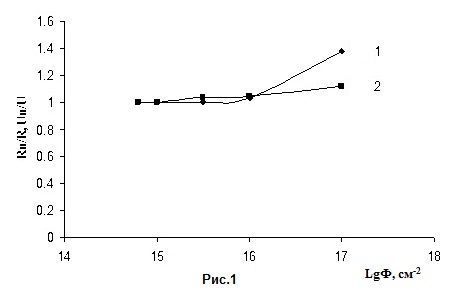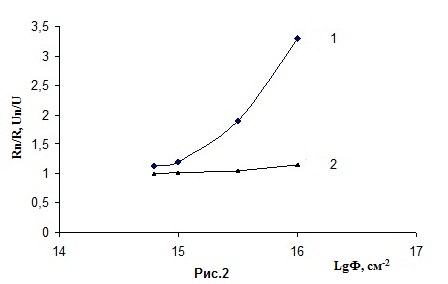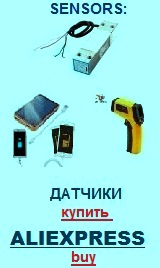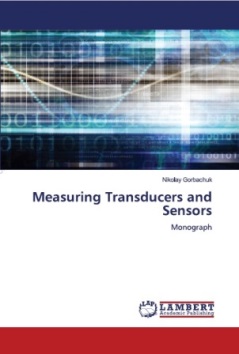Transducers, gauges, sensors - Information portal © 2011 - 2025 Use of material is possible by placing an active link
INFLUENCE of NEUTRON IRRADIATION ON DESCRIPTIONS of SEMICONDUCTOR MEASURING TRANSDUCERS of TEMPERATURE, DEFORMATION, MAGNETIC FIELD
Introduction
The development of nuclear power technology, increased demands on it in terms of ecology, as well as research in these areas requires the establishment of appropriate diagnostic tools.
Measured parameters are often highest level existing in the environment (eg , electromagnetic radiation ) . Therefore, these agents should have a high sensitivity to the controlled parameters and slightly be affected by outside influences. For such purpose there may be used semiconductor transducers with a suitable choice of material and construction of the sensor element.
Experimental part
The paper presents the results of experimental studies the influence of neutron irradiation on the basic characteristics of semiconductor temperature transmitters, strain, magnetic field on bulk particulate film and polycrystalline germanium (Ge-GaAs), polycrystalline silicon and epitaxial single-crystal epitaxial films of gallium arsenide [1,2 , 3]. It is known , for example [4,5 ] that the resistance of semiconductor devices to irradiation depends on the doping level of the semiconductor material defects, etc.
We investigated converters based on silicon films of n-type conductivity with the impurity concentration N = 1x10^19 cm- 3 , film n-GaAs c N = 8x10^17 cm- 3, p- germanium films with N = 5x10^17 cm- 3. Characteristics were measured at 300 K before irradiation and after irradiation by neutrons from F 8x10^14 cm- 2 to 1x10^17 cm -2. Temperature measurements stabilized to within 0.1 K. The neutron energy of 1 MeV flux intensity (2-4) x10^8 fl / s.
Figure 1 shows the relative change in input resistance Rn / R ( where Rn- resistance after exposure to neutrons , R - resistance to irradiation) transmitter strain on the magnitude of the neutron flux. Initial input impedance 1.7 ohms investigated sensors. The changes in resistance is observed to 1x10^16 cm- 2 and at 1x10^17 cm-2, it was increased by approximately 40 %. Initial output at a voltage of 4.5 V supply increased by 12%, which corresponds to the strain 40 million -1, and changes Gage not found.
Figure 2 shows the dependence of the relative change in the input resistance of the magnetic field transducers ( Hall sensors ) on the value of the neutron flux. Input impedance 1.1 k sensors, the initial output of not more than 4.5 mV sensitivity of 350 mV / T. Resistance changes begin by streams 1x10^15 cm -2 and amounts to 15-20 %, and at 2 - cm 1x10^16 resistance increases by 3.3 times. In this initial output at a constant voltage supply 4.5 V does not vary more than 15%, which is equivalent to the effect of the magnetic field of up to 1 mT. With a constant supply voltage sensitivity after irradiation decreased by approximately 1.4 times. After irradiation by 1x10^17 cm -2 sensor resistance increases to infinity.
Figure 3 shows the dependence of the relative change in resistance temperature transmitters ( RTDs ) based on the film and particulate
germanium. A slight decrease in the resistance to 1% for particulate germanium and to 10% for the film by streams 1x10^16 cm -2. Changes in temperature sensitivity transducers were found.
Conclusion
The results of the study indicate that maintaining performance transducers on the basis of these in the semiconductor materials after neutron irradiation to 1x10^16 cm -2 (GaAs, Ge) and to 1x10^17 cm -2 (Si).
Emerging changes in the characteristics of converters levels after 1x10^15 cm -2 can be considered to a certain extent, due to the fact that there has been a good repeatability. The converters can be used for diagnostics of technical devices of nuclear energy, and due to its high sensitivity to environmental control environmental parameters such as temperature, electromagnetic fields, vibrations, etc.
References
1. Report on R & D: Development and production of a set of diagnostic sensors for testing at the " Phoenix ." Kiev, 1994, 49c.
2 . Zhelamsky M.V., Konstantinov A.B., Sychevsky S.E. etc. A number of precision oscillators emf Hall . Problems of Atomic Science and Technology . Series: Electro- equipment. 2002. B. I ( 27), pp. 9-14.
3 . Gorbachuk N.T, Didenko P.I Measuring converters based on GaAs, and particulate polysilicon germanium and prospects of their use in terms of radiation exposure. XXXIII International Conference on the physics of the interaction of charged particles with crystals. M. May 26-28, 2003. Abstracts, p.160.
4 . Vikulin I.M., Stafeev V.I. Physics of semiconductor devices. M.: Radio and communication, 1990 . 264.
5 . Kulakov V.M., Ladigin E.A., Shekhovtsov V.I. etc. The action of ionizing radiation on electronic goods. Sov. radio, 1980. 224.
Gorbachuk N.T., Didenko P.I.. And Influence of neutron irradiation on descriptions of semiconductor measuring transducers of temperature, deformation, magnetic-field. Surface, 2005, 4, p.57-58.



ðóññêèé / english
Home >> Publication >> INFLUENCE of NEUTRON IRRADIATION ON DESCRIPTIONS of SEMICONDUCTOR MEASURING TRANSDUCERS of TEMPERATURE, DEFORMATION, MAGNETIC FIELD
• Information about various converters and sensors of physical quantities, parameters of various physical processes is presented.
• Electrophysical properties and effects in various electrical materials.
• Theory, experimental results, practical application

See also:
CONVERTERS, GAUGES, SENSORS
Information, news, advertising


